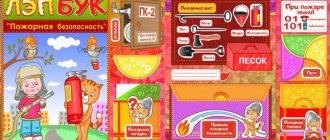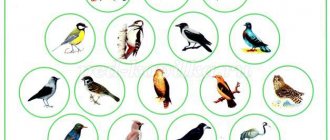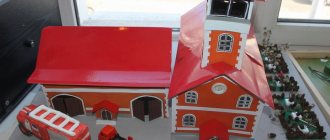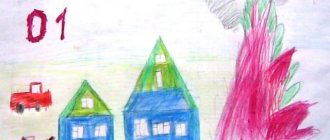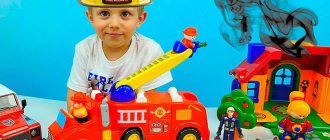Game "Fire".
At the signal (fire siren), the players run from the starting line to the chairs on which the equipment is laid out: helmet, gloves, belt, etc. They need to prepare for departure - put on the equipment. The one who gets dressed the fastest wins.
Game "Scouts".
On command, players must overcome an obstacle course, get to the chair with the doll, and “take it out of the fire.” The one who reaches the finish line first wins. The game can be complicated by asking the “scouts” to move blindfolded (heavy smoke). In this case, the obstacle course should be short and not very difficult.
Game "Firefighting".
At a given signal, players draw water from a large basin with a small bucket and pass it to each other, lining up in a chain. The latter pours water into an empty container. The team that fills it out the fastest wins.
Game "After the Fire".
Players sit on chairs, pick up reels, each of which has a cord (fire hose) attached to one end. The winner is the one who winds the cord onto the reel faster.
Questions and answers on fire safety
Goal : to consolidate knowledge about the correct actions in the event of a fire.
Progress of the game:
Questions and answers are presented in the form of pictures (questions on one tray, answers on the other). For each situation it is necessary to choose the right answer.
Situations:
- There was a fire.
- There is a lot of smoke in the room.
- Your clothes are on fire.
- The TV started smoking.
- The old grass is burning.
- I smelled gas.
- It is difficult to breathe from the acrid smoke.
Answers:
- Call "01".
- Crawl your way to the exit.
- Get on the floor and roll.
- Turn it off, cover with a blanket.
- Cover it with soil and fill it with water.
- Open the window, call “04”.
- Breathe through the wet rag.
Progress of the game:
The teacher gives the players cards drawn into 10 empty rectangles (playing fields, then shows the children a plot picture depicting the situation during a fire (a boy plays with matches , a girl ran out onto the balcony of a burning apartment, an iron was left unattended, children turned on the Christmas tree, etc.) The child who correctly described the situation covers the empty playing field with a picture ... The one who has the most closed fields wins.
Didactic game " Card Quiz "
.
Goal: to consolidate children's knowledge about fire safety rules . Develop memory, thinking, speech. Foster a sense of responsibility.
Fire safety game Prohibited - allowed
Objectives: consolidation of knowledge about basic fire safety requirements; increasing personal responsibility for one’s actions; formation of discipline, sense of duty.
Material:
Each child has one signal card - “traffic light”. One side of the green traffic light is “permissive”, the other side is red – “prohibiting”.
Progress of the game:
The teacher names the basic fire safety requirements in random order, and the children show the corresponding “traffic light” colors.
Methodological material for the game:
Prohibited:
- Throw burning matches and cigarette butts indoors.
- Throw away burning ash near buildings.
- Leave the doors of stoves and fireplaces open.
- Use homemade devices and fuses.
- Connect a large number of current consumers (more than three) to one outlet.
- Use faulty equipment and devices.
- Use damaged sockets.
- Wrap electric lamps and lamps with paper, cloth and other flammable materials.
- Use electric irons, stoves, kettles without stands made of fireproof materials.
- Leave electrical heating devices, radios, etc. plugged in unattended.
- Use electrical cords and drives with damaged insulation.
- Set up workshops and warehouses in apartments of residential buildings where explosive materials are used and stored.
- Leave burning stoves unattended, and also entrust small children with supervision of them.
Necessary:
- Protect yourself, property, residential building, cottage, garage, car, as well as state property from fire.
- In the event of a fire, call the fire department by phone “01”, provide the address where the fire occurred and give your last name.
- Evacuate children, sick, elderly, and disabled people from fires.
- Sound the alarm.
- Meet the firefighters and inform them about the fire.
- Post a sign in the educational institution indicating the emergency telephone number of the fire department: “01”.
- Learn to use a fire extinguisher;
- Know the evacuation plan in case of fire.
- Do not open doors in the room where the fire has occurred.
- Scream and call adults for help.
- Cover your nose and mouth with a wet bandage (handkerchief, scarf) to protect from smoke.
- Throw a piece of thick cloth moistened with water, a wet blanket, a raincoat, or a coat over yourself when you are in a fire zone.
- Move by crawling or crouching along the wall if the room is heavily smoky.
- Throw a blanket over the victim if his clothes catch fire, and press it tightly against the person’s body to stop the access of air.
- Extinguish clothes by taking them off or pressing yourself to the ground, floor, or wall.
- Open windows and doors for ventilation in smoky rooms where there is no fire.
- Remove the victim who has been taken outside from his clothes or unfasten the collar and loosen the clasp.
- Call an ambulance for the victim by calling “03” and send him to the hospital.
Didactic game “What is useful in case of fire?”
Didactic game “What is useful in case of fire?”
Goal: by introducing children to the firefighter profession, to form an understanding of the objects that make the work of people in this profession easier.
Tasks:
-continue to teach how to play various educational games;
- deepen understanding of the essential characteristics of objects, the possibility of using them in an emergency;
-develop the ability to identify and name items necessary for firefighting from a group of items, explaining your choice;
-continue to teach how to coordinate your actions with the actions of the host and other participants in the game;
-develop the ability to independently unite for joint games;
-develop intelligence and the ability to independently solve a given problem;
-promote the manifestation and development of logical thinking and cognitive activity in the game;
-nurture friendly relationships between children, the ability to negotiate, and help each other.
Game contents:
• cards with items necessary for firefighting – 6 pcs. ;
• cards with items that are not used in fire fighting – 6 pcs.
• cards consisting of six subject pictures – 2 pcs. ;
• playing fields “Useful in case of fire”, “Not useful in case of fire” - 2 pcs.
Number of players: one or more
Options for game tasks.
Option 1 (from 4 to 5 years)
Number of participants: from one or more
Progress of the game: the presenter shows the card, and the child explains whether this item is needed (not needed) when extinguishing a fire. If several players participate in the game, they are given a token for the correct answer. The player who has the most tokens at the end of the game wins.
Option 2 (from 4 to 6 years)
Number of participants: from one or more
Game progress: players take cards with six subject pictures on each (one card for each player). The leading player takes a card with one subject picture and shows it to the players. The player who has the corresponding item on the card takes it and places it on his card. The player who has all the pictures on the card covered wins. The winning player is given the opportunity to be the host for the next game.
Complicating the game: the presenter, without showing the card, names the object that is depicted on it. The player who has the corresponding item on their card raises their hand or says, “I have this card.” The presenter compares the illustrations and, if there is a match, gives the card to the player.
Option 3 (from 6 to 7 years old)
Number of participants: from one or more
Progress of the game: players share cards with subject pictures (six cards for each player) and playing fields “Useful in case of fire”, “Not useful in case of fire”. Each player chooses from his cards those that fit the playing field. Cards that do not fit on the playing field must be exchanged with the second player. You can exchange them in the following way: explain why this or that item is needed (or why it is not needed) in case of a fire. The player who has all the pictures on the card covered wins.
https://www.maam.ru/detskijsad/didakticheskie-igry-pozharnaja-bezopasnost-dlja-detei-starshego-doshkolnogo-vozrasta.html
The purpose of the didactic game “Who needs what”
The goal is to become familiar with professions and their associated attributes.
Tasks:
- consolidation of names and ideas about professions;
- familiarization with objects and tools used by specific specialists;
- developing the skill of relating work wardrobe to professions;
- fostering a respectful attitude towards work;
- strengthening cognitive interest;
- development of memory, speech skills, concentration, ability to think logically.
Progress of the game:
The teacher lays out on the table, or puts in a beautifully decorated box, cards with questions on the topic of rules of behavior during a fire . The child who answers the question correctly The one who has the most chips at the end of the game wins.
Question options:
- Name the possible cause of the fire ;
- how to call the fire department correctly ;
- what to do if during a fire there is no way to call the fire brigade , and the routes out of the house are cut off by the fire ;
— is it possible to extinguish a fire without first calling the fire brigade ;
- what to do if there is a smell of gas in the house;
— is it possible to hide in a closet or under a table during a fire ;
— Is it possible to set poplar fluff on fire?
— Is it possible to create a draft during a fire by opening all windows and doors at the same time;
— is it possible to use the elevator during a fire in the house ;
first during : money, documents or yourself;
— how to properly leave a smoky room;
— Is it possible to play with matches and lighters and why.
Didactic game : “Name the causes of the fire ”
Goal: to develop knowledge about the causes of fire . Develop attention, memory, speech. Cultivate responsibility.
Progress of the game:
From the plot pictures (children collecting autumn leaves, children hanging burning candles on the Christmas tree, a boy playing with matches , children watering flowers, etc.), the child must choose those situations that could cause a fire and justify his answer, for that gets the chip. The one who has the most chips at the end of the game wins.
Didactic game : “Choose the right one”
Goal: to develop children’s knowledge about the items needed when extinguishing a fire , the rules for their use . Reinforce knowledge about objects that can cause a fire . Develop speech, memory, logical thinking. Foster a sense of responsibility.
Progress of the game:
The child is offered a set of subject pictures (fire extinguisher, bucket of water, TV, telephone, sandbox, electrical socket, fire hose, kerosene fireman's helmet , lighter, gas stove, gas mask) from which he must select those used in extinguishing fires and those that are the cause fire occurrence . The one who answers correctly gets a chip. The player who receives the most chips wins.
Didactic game : “Fold the picture ”
Goal: to consolidate knowledge about the rules of behavior during a fire . Develop imagination, logical thinking, fine motor skills. Cultivate perseverance.
Work clothes
For this lesson you will need paper cut-out images of a boy and a girl, different types of work wardrobe, as well as corresponding professional tools.
The presenter explains that the paper dolls are going to work, and you need to help them choose a suitable wardrobe. Then he places a picture of a tool next to each doll, from which the players must guess what item of clothing is needed. Children dress dolls and name their profession. And so for every work clothing.
Progress of the game:
The child is shown a picture depicting various uses of fire (both good and bad)
.Children are given
cards with images of fire and objects related to fire (matches, firewood, gas stove, kerosene lamp, etc.)
Children must place
the cards on the picture - in the right place .
Didactic game : “Say a word”
Goal: to consolidate knowledge about fire . Develop vocabulary, attention, memory.
